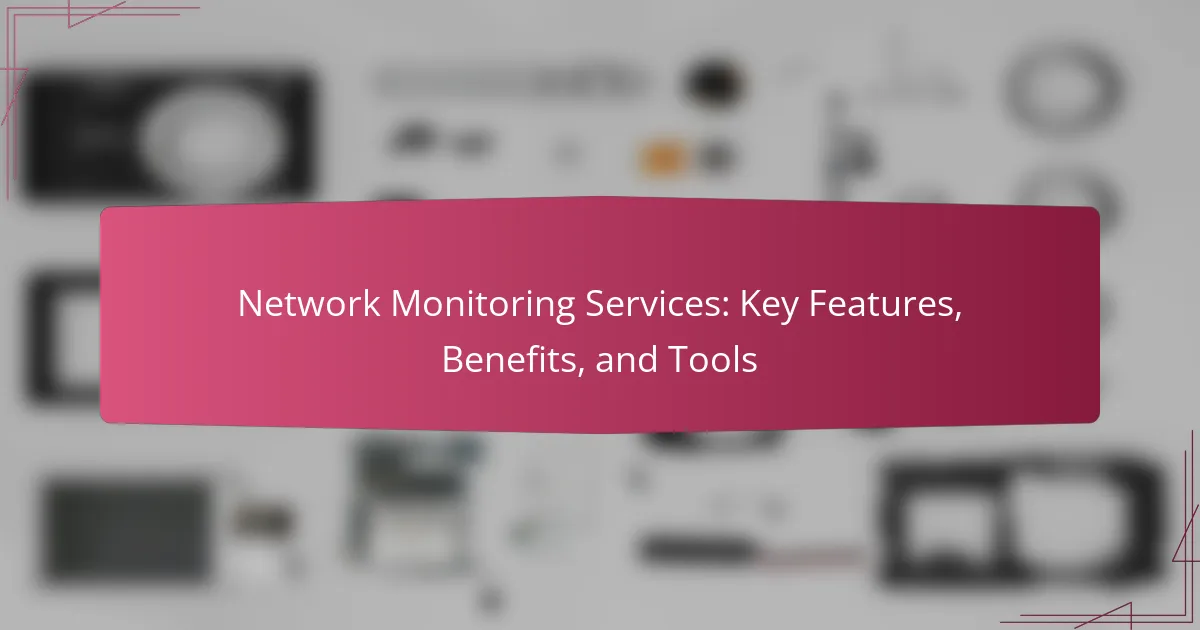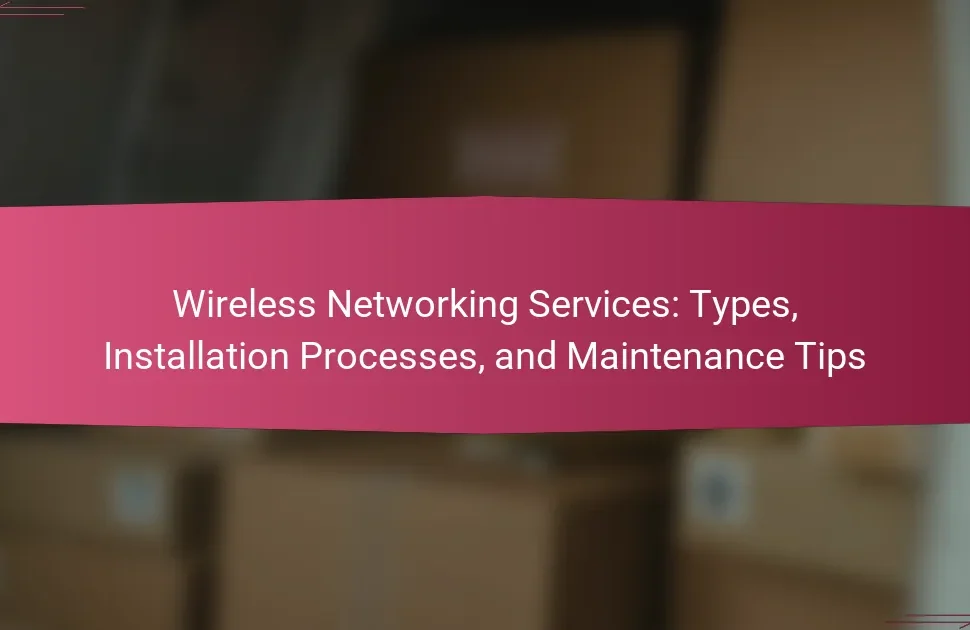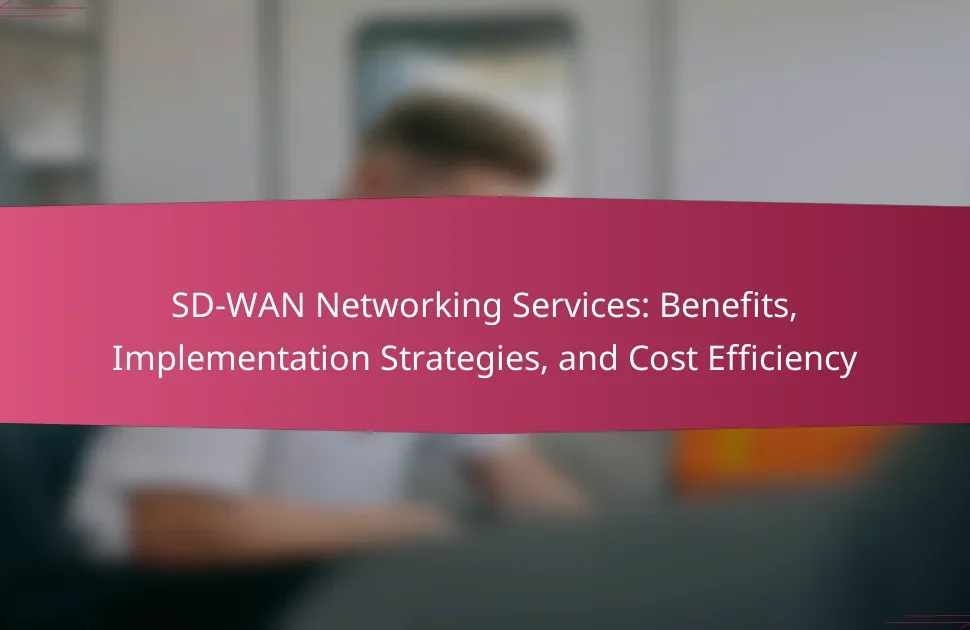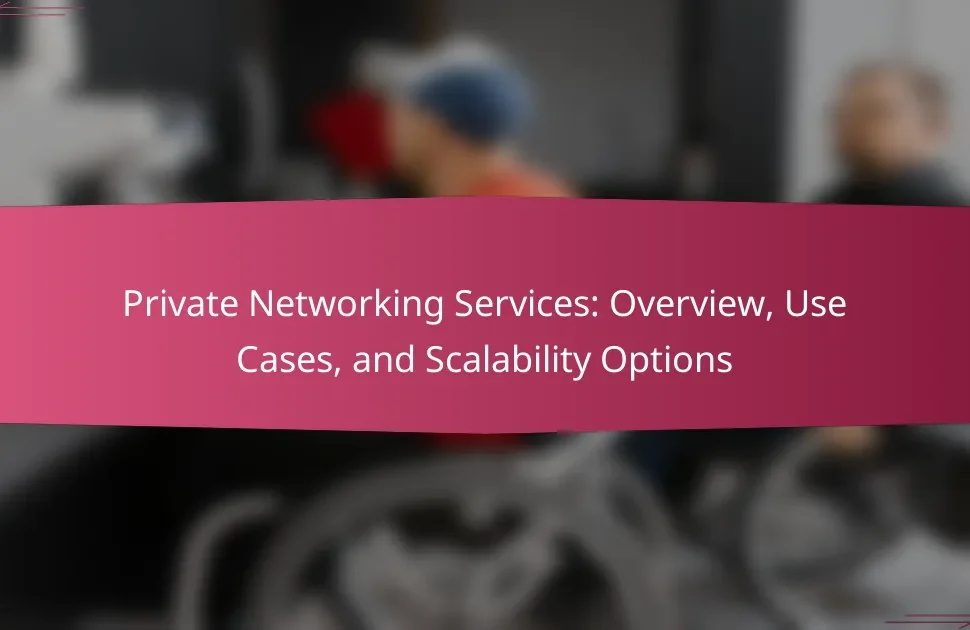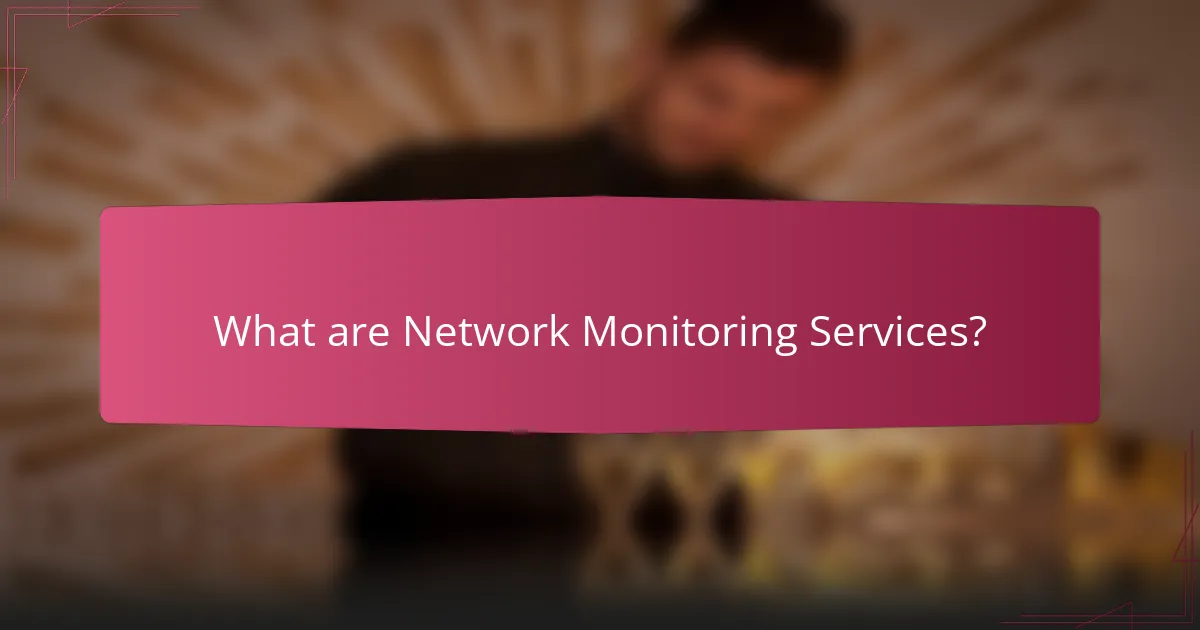
What are Network Monitoring Services?
Network monitoring services are tools and processes that oversee network performance and health. They identify issues such as downtime, slow performance, and security threats. These services provide real-time insights into network traffic and device status. They help ensure optimal network operation and reliability. Monitoring can include tracking bandwidth usage, device availability, and application performance. Many organizations use these services to prevent outages and enhance security. According to a report by MarketsandMarkets, the global network monitoring market is expected to grow significantly, highlighting its importance in IT infrastructure management.
How do Network Monitoring Services function?
Network monitoring services function by continuously observing network performance and health. They utilize specialized software and tools to track various parameters. These parameters include bandwidth usage, latency, and packet loss. The services collect data from network devices and systems. This data is analyzed to identify issues or anomalies. Alerts are generated for any detected problems. Network administrators can then respond to these alerts in real-time. Studies indicate that effective monitoring reduces downtime by up to 50%.
What technologies are utilized in Network Monitoring Services?
Network monitoring services utilize various technologies to ensure network performance and reliability. These technologies include network management software, which provides tools for monitoring and analysis. Additionally, SNMP (Simple Network Management Protocol) is widely used for collecting and organizing information about network devices. Packet sniffers are also employed to capture and analyze data packets traveling across the network. Performance monitoring tools help assess bandwidth usage and latency. Network mapping tools visualize network topology and device connections. Log management systems track and analyze logs for security and troubleshooting. Finally, cloud-based monitoring solutions offer scalability and remote access capabilities.
What is the role of data collection in Network Monitoring Services?
Data collection is essential in Network Monitoring Services. It enables the continuous gathering of network performance metrics. These metrics include bandwidth usage, latency, and error rates. Accurate data collection allows for real-time analysis of network conditions. This helps in identifying issues before they impact users. Furthermore, data collection supports trend analysis over time. This assists in capacity planning and resource allocation. Effective data collection enhances the overall reliability and efficiency of network operations.
What key features do Network Monitoring Services offer?
Network monitoring services offer essential features for tracking network performance. These features include real-time monitoring of network devices and traffic. They provide alerts for performance issues and potential outages. Additionally, they offer reporting tools for analyzing network health over time. Many services include automated troubleshooting capabilities. They often support various protocols for comprehensive monitoring. Security monitoring is also a key feature, detecting unauthorized access or vulnerabilities. Network monitoring services are crucial for maintaining optimal network performance and security.
How do alerting and notification systems work in Network Monitoring Services?
Alerting and notification systems in Network Monitoring Services detect and communicate network issues in real-time. They continuously monitor network performance metrics, such as bandwidth usage and latency. When a predefined threshold is breached, the system triggers an alert. This alert can be sent via email, SMS, or through a dashboard notification.
Alerting systems use specific parameters to identify critical issues. For example, a sudden spike in traffic may indicate a potential DDoS attack. Notifications ensure that network administrators are informed promptly to take necessary actions. Many systems allow customization of alert settings based on the organization’s needs.
These features enhance network reliability and minimize downtime. According to a 2021 report by Network World, effective alerting can reduce response times by up to 50%. This demonstrates the importance of timely notifications in maintaining network health.
What types of performance metrics are tracked by Network Monitoring Services?
Network Monitoring Services track several key performance metrics. These metrics include network uptime, which measures the availability of network services. Latency is another critical metric, indicating the time taken for data to travel from source to destination. Bandwidth usage is monitored to assess the amount of data transmitted over the network. Packet loss is tracked to identify data packets that fail to reach their destination. Additionally, response time is measured to determine how quickly a network responds to requests. These metrics provide insights into network performance and reliability. Monitoring these metrics helps organizations optimize their network infrastructure.
What benefits do Network Monitoring Services provide?
Network monitoring services provide enhanced network performance, security, and reliability. They enable real-time monitoring of network traffic and performance metrics. This helps identify and resolve issues before they affect users. Network monitoring services also enhance security by detecting unauthorized access and potential threats. They facilitate compliance with industry regulations by maintaining logs and reports. Additionally, these services can optimize resource utilization, ensuring efficient bandwidth management. According to a report by Gartner, organizations utilizing network monitoring tools experience a 30% reduction in downtime.
How do Network Monitoring Services enhance network security?
Network monitoring services enhance network security by providing real-time visibility into network activity. They detect suspicious behavior and potential threats quickly. These services analyze traffic patterns and identify anomalies. They also facilitate the monitoring of devices and endpoints on the network. Alerts are generated for unusual activities, enabling prompt responses. Regular reports help in assessing the overall security posture. According to a report by Gartner, organizations using network monitoring tools reduce incident response times by up to 50%. This demonstrates the effectiveness of network monitoring in enhancing security.
What cost savings can businesses achieve through Network Monitoring Services?
Businesses can achieve significant cost savings through Network Monitoring Services. These services help identify and resolve network issues before they escalate. By preventing downtime, businesses avoid loss of revenue. A study by Gartner indicates that network downtime can cost businesses up to $5,600 per minute. Efficient monitoring reduces the need for extensive IT resources. It also minimizes the risk of data breaches, which can be financially devastating. Furthermore, businesses can optimize their network performance, leading to better resource allocation. Overall, proactive network management translates into substantial financial benefits over time.
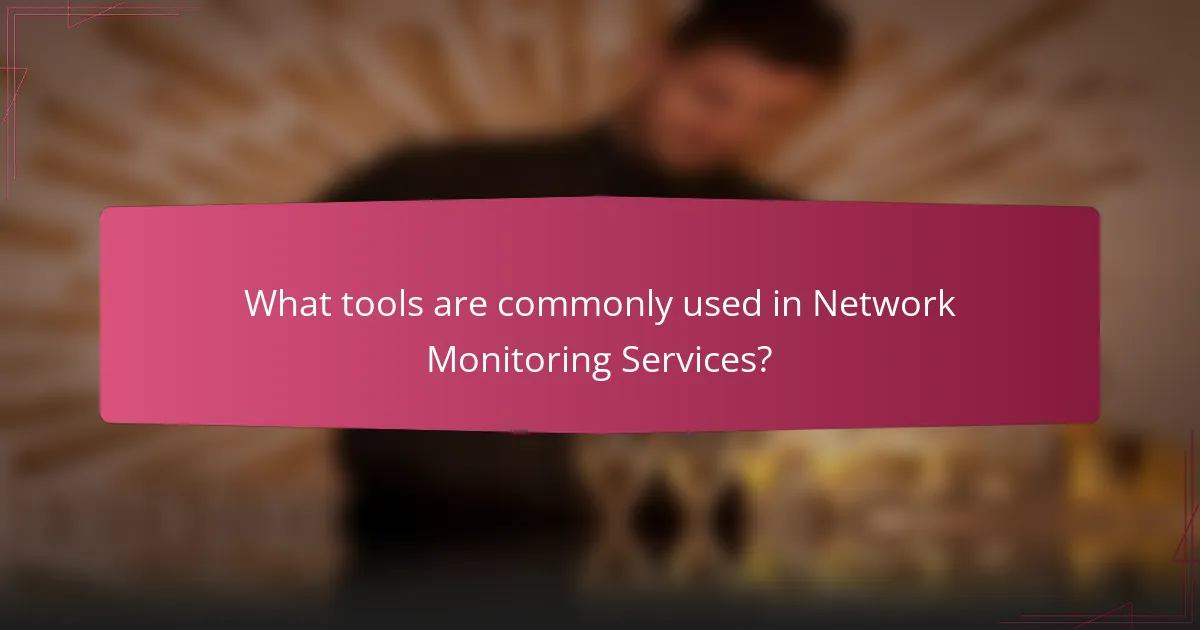
What tools are commonly used in Network Monitoring Services?
Common tools used in Network Monitoring Services include Nagios, Zabbix, and SolarWinds. Nagios is popular for its open-source capabilities and extensive plugin support. Zabbix offers real-time monitoring and alerting features. SolarWinds is known for its user-friendly interface and comprehensive network performance monitoring. These tools help organizations track network health, performance, and security. They provide essential insights for maintaining optimal network operations.
How do different Network Monitoring tools compare?
Different network monitoring tools vary in features, performance, and usability. Tools like SolarWinds and PRTG offer extensive functionalities for real-time monitoring. They provide alerts and reporting features that enhance network visibility. In contrast, simpler tools like Nagios focus on basic monitoring capabilities. They may lack advanced analytics but are highly customizable. The performance of these tools can differ based on network size and complexity. For example, SolarWinds is often favored for large enterprises due to its scalability. User interface and ease of use also differ significantly among tools. Many users prefer tools with intuitive dashboards for quick insights. Ultimately, the choice depends on specific network needs and budget constraints.
What are the top features of popular Network Monitoring tools?
The top features of popular Network Monitoring tools include real-time monitoring, alerting, and reporting capabilities. Real-time monitoring allows users to track network performance continuously. Alerting features notify users of potential issues immediately. Reporting capabilities provide insights into network usage and performance trends over time. Additionally, network visualization tools offer graphical representations of network topology. Integration with other IT management tools enhances functionality. User-friendly dashboards simplify data interpretation. Support for various protocols ensures compatibility with diverse network devices. These features collectively contribute to effective network management and optimization.
How do open-source tools differ from commercial Network Monitoring tools?
Open-source tools differ from commercial network monitoring tools primarily in cost and flexibility. Open-source tools are typically free to use and modify. This allows for extensive customization to meet specific needs. Commercial tools often come with licensing fees and limited customization options.
Open-source tools benefit from community support and contributions. This can lead to rapid updates and a wide range of features. Commercial tools usually offer dedicated customer support and more polished user interfaces.
Security can also vary; open-source tools rely on community scrutiny for vulnerabilities. In contrast, commercial tools often have formal security audits. Overall, the choice between them depends on budget, required features, and support preferences.
What should you consider when choosing Network Monitoring tools?
When choosing network monitoring tools, consider scalability, ease of use, and compatibility. Scalability ensures the tool can grow with your network’s demands. Ease of use affects how quickly your team can adopt and utilize the tool effectively. Compatibility with existing infrastructure is crucial for seamless integration. Additionally, assess the tool’s reporting capabilities and alerting features for proactive management. Finally, evaluate the level of customer support offered by the vendor. These factors collectively contribute to the overall effectiveness of the monitoring solution.
How does scalability impact your choice of Network Monitoring tools?
Scalability significantly influences the selection of Network Monitoring tools. It determines whether a tool can grow alongside your network’s demands. A scalable tool can accommodate increased data traffic and more devices without compromising performance. This adaptability is crucial for organizations anticipating growth or fluctuations in network activity. Tools lacking scalability may require costly replacements or upgrades as networks expand. According to a report by Gartner, 70% of organizations faced challenges due to inadequate scalability in their monitoring solutions. Thus, prioritizing scalability ensures long-term efficiency and cost-effectiveness in network management.
What is the importance of user interface in Network Monitoring tools?
The user interface in network monitoring tools is crucial for effective management and analysis. A well-designed user interface enhances user experience and improves accessibility to vital data. It allows network administrators to quickly identify issues and respond promptly. Intuitive layouts reduce the learning curve for new users. Clear visualizations present complex data in an understandable format. Efficient navigation enables users to access different functionalities seamlessly. According to a study by Nielsen Norman Group, usability directly impacts productivity and error rates in software applications. Therefore, a strong user interface is essential for maximizing the effectiveness of network monitoring tools.
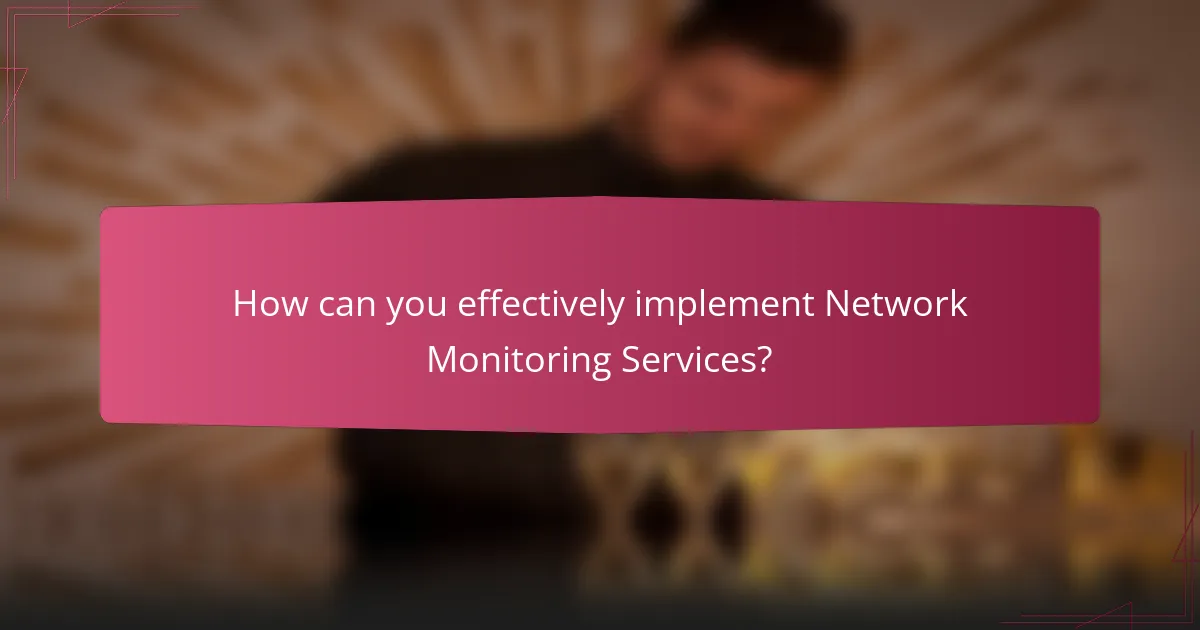
How can you effectively implement Network Monitoring Services?
To effectively implement Network Monitoring Services, begin by defining your monitoring objectives. Identify critical network components that require oversight. Choose appropriate monitoring tools that align with these objectives. Deploy the selected tools across the network infrastructure. Configure alerts for performance issues and anomalies. Regularly review monitoring data to identify trends and potential problems. Ensure that team members are trained to respond to alerts effectively. Conduct periodic assessments to refine monitoring strategies based on evolving network needs.
What are the best practices for deploying Network Monitoring Services?
The best practices for deploying Network Monitoring Services include defining clear objectives, selecting appropriate tools, and ensuring proper configuration. Establishing objectives helps to identify what needs monitoring. Choosing the right tools is essential for effective data collection. Proper configuration ensures that the monitoring system accurately reflects the network environment. Regularly updating the monitoring tools is crucial to maintain effectiveness. Additionally, training staff on using the monitoring services enhances operational efficiency. Implementing alerts for critical issues allows for timely responses. Finally, reviewing performance metrics periodically helps to optimize monitoring strategies.
How can you ensure continuous improvement in your Network Monitoring strategy?
To ensure continuous improvement in your Network Monitoring strategy, regularly assess and update your monitoring tools and processes. Implement a feedback loop that incorporates insights from network performance data. Analyze incidents to identify recurring issues and develop preventive measures. Conduct regular training sessions for your team to stay updated on best practices. Set specific performance metrics to evaluate the effectiveness of your monitoring strategy. Utilize automation to enhance efficiency and reduce human error. Regularly review industry standards and adapt your strategy accordingly. Continuous improvement can lead to enhanced network reliability and performance.
What common challenges might arise with Network Monitoring Services?
Common challenges that might arise with Network Monitoring Services include false positives and negatives. False positives occur when the system incorrectly identifies a problem. This can lead to unnecessary alerts and wasted resources. False negatives happen when actual issues go undetected. This can result in significant downtime or data loss.
Another challenge is the complexity of network environments. Modern networks often include various devices and technologies. This diversity can complicate monitoring efforts. Additionally, inadequate integration with existing tools can hinder effectiveness.
Scalability also poses a challenge. As networks grow, monitoring solutions must adapt. Failure to scale can lead to performance issues. Lastly, managing and analyzing large volumes of data can overwhelm teams. This can impede timely decision-making and response.
How can you troubleshoot issues in Network Monitoring Services?
To troubleshoot issues in Network Monitoring Services, start by identifying the specific problem. Check network connectivity to ensure all devices are operational. Review logs for error messages or alerts that indicate failures. Validate configuration settings for accuracy and compliance with best practices. Test the monitoring tools to confirm they are functioning correctly. Analyze performance metrics to pinpoint any anomalies. Engage with support resources if issues persist, utilizing vendor documentation or community forums for guidance. This systematic approach helps isolate and resolve issues effectively.
What strategies can help mitigate potential challenges in Network Monitoring?
Implementing automated monitoring tools can mitigate challenges in network monitoring. Automation reduces human error and enhances efficiency by continuously tracking network performance. Regularly updating monitoring software ensures compatibility with new technologies. Establishing clear protocols for incident response can streamline troubleshooting processes. Training staff on network monitoring tools improves overall effectiveness. Utilizing data analytics helps in identifying trends and potential issues proactively. Conducting periodic network assessments can uncover vulnerabilities before they become critical. Collaborating with third-party experts can provide additional insights and resources for complex network environments.
What practical tips can enhance your use of Network Monitoring Services?
Utilizing Network Monitoring Services effectively requires specific strategies. First, establish clear objectives for monitoring. Define what aspects of the network are most critical to your operations. Next, leverage automated alerts to receive real-time notifications. This allows for quicker responses to potential issues. Regularly review monitoring reports to identify trends and anomalies. This practice aids in proactive maintenance and troubleshooting. Additionally, integrate monitoring tools with existing IT infrastructure. This enhances visibility and streamlines operations. Finally, train staff on using these services. Proper training ensures that team members can maximize the tools’ capabilities. Following these tips can significantly improve network performance and reliability.
Network Monitoring Services are essential tools and processes that oversee network performance and health, identifying issues such as downtime and security threats. This article provides an overview of how these services function, the technologies utilized, and the key features they offer, including real-time monitoring and alerting systems. It also discusses the benefits of network monitoring, such as enhanced security and cost savings, and examines various tools available in the market. Additionally, the article outlines best practices for implementation and strategies to overcome common challenges associated with network monitoring.
